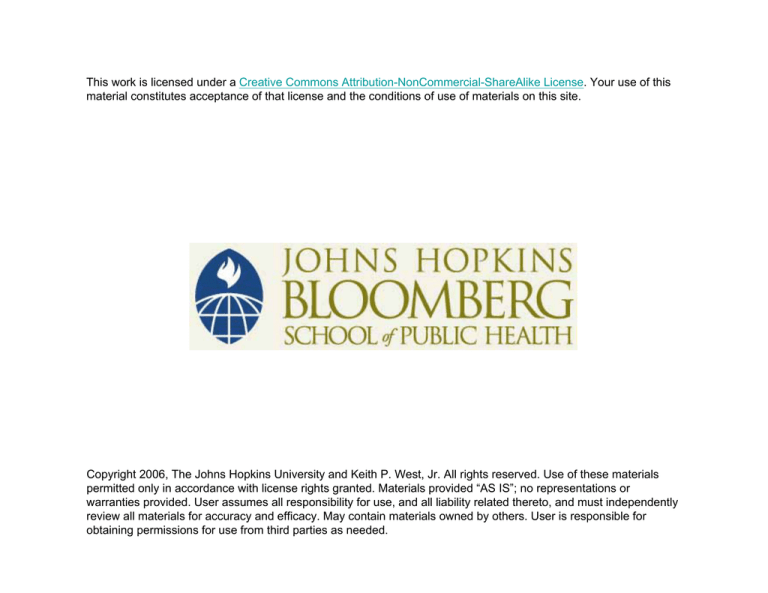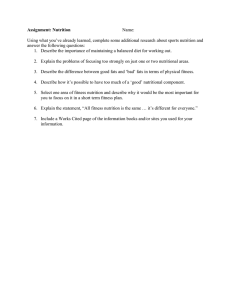
This work is licensed under a Creative Commons Attribution-NonCommercial-ShareAlike License. Your use of this
material constitutes acceptance of that license and the conditions of use of materials on this site.
Copyright 2006, The Johns Hopkins University and Keith P. West, Jr. All rights reserved. Use of these materials
permitted only in accordance with license rights granted. Materials provided “AS IS”; no representations or
warranties provided. User assumes all responsibility for use, and all liability related thereto, and must independently
review all materials for accuracy and efficacy. May contain materials owned by others. User is responsible for
obtaining permissions for use from third parties as needed.
International Nutrition
Current & Emerging Issues
in Nutrition, Health & Survival
Keith P. West, Jr. DrPH, MPH
International Nutrition:
Major Nutritional Problems
• General food insecurity
• Protein-energy malnutrition (PEM)
• Micronutrient deficiencies
• Vitamin A deficiency & disorders
• Iron deficiency anemia
• Zinc deficiency
• Iodine deficiency & disorders
• Other micronutrient deficits
• Infection and infectious morbidity
• Overweight & obesity
• Chronic diseases of imbalance and overabundance
International Nutrition:
Responses to Nutritional Stress
• Household Responses:
•
•
•
•
•
Breast feeding/Complementary feeding
Home-based fortification
Improving household food security (quantity, quality distribution)
Improving household hygiene
Food and non-food budgeting
• Community Responses:
• Growth monitoring & promotion
• Supplementary feeding
• Cooperatives
• Nutrition education activities
• National and International Responses:
•
•
•
•
Nutritional surveillance and program monitoring
Food aid
National food & nutrition policies
Multilateral and bilateral assistance programs
International Nutrition:
Other Issues Covered
•
•
•
•
•
Obesity and the Nutrition Transition
Nutrition and Reproductive Health
HIV and Micronutrient Nutrition
Epidemiology of Famine
Nutritional Problems Emerging from Student
Papers (aka consultant reports!)
Population Distributions of Nutritional Status
Normally Nourished
Undernourished
Deficient
Population Distribution
Overnourished
Overweight/Obese
Toxic
For more information see: West et al. Nutrition. Intl Public Health. Aspen:Gaithersberg, 2001
Population Distributions of Nutritional Status
Mostly Undernourished (PEM, Micronutrient Deficiencies)
Normally Nourished
Undernourished
Deficient
Famished
Population Distribution
Overnourished
Overweight
Toxic
For more information see: West et al. Nutrition. Intl Public Health. Aspen:Gaithersberg, 2001
Population Distributions of Nutritional Status
Mostly Undernourished (PEM, Micronutrient Deficiencies)
Normally Nourished
Undernourished
Deficient
Famished
Population Distribution
Overnourished
Overweight
Toxic
FN
TP
FP
TN
Low weight for height..…Normal weight for height
Low circulating retinol….Normal circulating retinol levels
Low hemoglobin…………Normal hemoglobin
Low urinary iodine………Normal iodine status
For more information see: West et al. Nutrition. Intl Public Health. Aspen:Gaithersberg, 2001
Burden of Undernutrition
• ~20% of world popn → inadequate food
• Growth failure → ~1/3 of children
• ~40% of women → under weight and/or
anemic
• >1 billion suffer nutritional deficiencies
ACC/SCN of the UN 2000
Spectrum of Nutritional Conditions
Spectrum of
nutritional
well-being and
examples of
types of
responses in
developing
countries.
Overnutrition Normal
Undernutrition
Famine
Types of Responses
Food & Nutrition Policies
Household Food Security Decisions
Growth Monitoring Screening
Treatment
Supplementary Feeding
Food Aid
Disaster Relief
World Declaration on the Survival,
Protection and Development of
Children
Plan of Action for Implementing the
World Declaration on the Survival,
Protection and Development of
Children in the 1990s
UNICEF 1990
World Summit for Children 1990: Nutrition Goals
• Reduce severe & moderate malnutrition < 5 yrs by half of
1990 levels;
• Reduce rate of low birth weight (< 2.5 kg) to < 10 %;
• Reduce iron deficiency anemia in women by 1/3 of 1990
levels;
• Virtually eliminate iodine deficiency disorders;
• Virtually eliminate vitamin A deficiency and consequences,
including blindness;
• Empower women to exclusively breast-feed for four to six
months (now 6 months) and to continue breastfeeding, with
complementary food, well into the second year;
• Institutionalize growth promotion and monitoring in all
countries by the end of the 1990s;
• Disseminate knowledge and support services to increase
food production to ensure household food security.
December 1992
FAO & WHO
By the year 2000 . . . eliminate:
• famine and related deaths
• starvation
• man-made disaster-induced
deficiencies
• iodine deficiency
• vitamin A deficiency
ICN, Rome 1992
World Food Summit of 1996
FAO
•Monitoring adequacy of food supplies
•Gender equality for education, training in food industry
•Increased expert guidance to countries on human nutrition
•Improved opportunities for nutrition education
•Attention to food quality and safety
•Ensure fair food trade practices
•Establish linkages between nutrition and development
Millennium Development Goals (MDGs)
(based on Goals at UN Millennium Summit, Sept 8, 2000)
1.
2.
3.
4.
5.
6.
7.
8.
Eradicate extreme poverty and hunger
Achieve universal primary education
Promote gender equality
Reduce child mortality
Improve maternal survival
Combat HIV/AIDS, malaria & other diseases
Ensure environmental sustainability
Develop a Global Partnership for Development
www.developmentgoals.org
Goal 1: Eradicate Extreme Poverty and
Hunger
Target 1: Halve, between 1990 and 2015, the
proportion of people whose income is less
than $1 (0.80 Euros) a day
Target 2: Halve, between 1990 and 2015, the
proportion of people who suffer from hunger
www.developmentgoals.org
•Clinical treatment protocols
(eg, severe PEM, keratomalacia)
•Supplementary feeding
•Nutrition surveillance & surveys
•Direct nutrient provision
•Supplementation
•Food fortification
•Feeding programs
•Nutrition education
•Food subsidies
•Horticulture (gardens)
•Pisciculture (fish farms)
•Animal husbandry
•Education
•Equal opportunity
•Health care system
•Market access
•Food aid
•Good governance
•Economic & development plans
•Grains & livestock production
•Trade policies
•Human rights (including food & nutrition)
Undernutrition
Wasting
Stunting
Underweight
Micronutrient Deficiencies
Severe Wasting w/ edema
Three-year old Indonesian
boy with measles,
marasmic-kwashiorkor
and keratomalacia (right eye).
The synergy between
malnutrition and infection
can be devastating,
threatening a child's sight
and life.
Photo: Alfred Sommer
Mild-to moderate stages
of undernutrition are
clinically less evident,
less acute but much more
frequent, associated with
increased risks of poor
health, developmental
delay and mortality.
Most preschool child
deaths occur among
those who are mildly-tomoderately
undernourished.
Photo: Keith West
Underweight in Under Fives
•
•
•
•
•
Excess infection
Excess mortality
Decreased activity
Delayed development
Poor school performance
ACC/SCN, 1991
Micronutrient Malnutrition:
Hidden Hunger
• ~2 billion people affected
• VA, iron, iodine, and zinc deficiencies
• Effects: poor growth, increased
morbidity, intellectual impairment,
increased mortality
• Preventable: supplements,
fortification, diet change
Poor Dietary Quality
A key determinant of multiple
micronutrient deficiencies
and complex nutritional
etiologies of poor growth and
increased morbidity
Vitamin A Deficiency
•
•
•
•
•
4-5 million……... children with xerophthalmia
125-130 million.. deficient children
1-2.5 million…… child deaths/year
~7 million……… deficient women
~6 million……… night blind pregnant women
KP West J Nutr 2002
Iron Deficiency
and Anemia
World’s Most Common
Micronutrient Deficiency
Iron Deficiency/Anemia:
A Major Global Problem
• ~ 2 billion anemic
• Severe anemia → high mortality
• Mild to moderate anemia
Impairs child development
Decreases work capacity
Pregnancy complications
Anemia: Many Causes
•
•
•
•
•
Iron deficiency
Other nutritional deficiencies
Hookworm
Malaria
Chronic infection (HIV)
Anemia: Many Solutions
•
•
•
•
•
Iron supplementation
Supplement with other nutrients
Deworm/hygiene
Malaria prophylaxis
Prevent chronic infections
Iodine Deficiency Disorders
WHO 2004
54 countries with IDD as public health problem based
on urinary iodine concentration
Effects of Iodine Deficiency
on Neural Function
•
•
•
•
•
Intelligence
Learning capacity
School performance
Cognition
Other outcomes
Zinc Deficiency
• Vast problem, hard to assess
• Low meat, high grain diets
• Increases risk of
Diarrhea
Respiratory infection
Severe malaria
Death (likely)
Zinc in the National Food Supply
(% mean per capita requirement)
>100%
75-99%
50-74%
< 50%
For more information see: Food & Nutrition Bulletin, v25,n1, March 2004.
Effects of Daily Zinc Supplement Use on Diarrhea
and Pneumonia in Preschoolers
Diarrhea Incidence
9 countries
~25% reduction
for diarrhea
Diarrheal Prevalence
9 countries
Pneumonia Incidence
4 countries
For more information see: Zinc
Investigators’ Collaborative Group
J Pediatrics 1999;135:689
~40%% reduction
for pneumonia
0 0.25 0.5 0.75 1 1.25 1.5 1.75 2
Odds Ratio and 95% CI
Household and Mother: 1st Line of Response
Photo: Keith West
Breast and Complementary Feeding
Source: WHO/NUT/98.1
Breast feeding…
•Today, 23 March 2004,
UNICEF and WHO launched
the “Global Strategy for Infant
and Young Child Feeding”:
Goal: “Exclusive breast feeding
in the first half-year of life and
continued breast feeding
coupled with appropriate foods
thereafter to reduce the number
of children < 5 dying from
malnutrition”
www.who.int/mediacentre/releases/2004
Household Food Security
Adequate access to food
needed for a healthy and active
life for all household members
(in terms of quality, quantity,
safety, cultural acceptance, and
future expectations).
ACC/SCN, 1991
“Although malnutrition has
multiple causes, reality
simply is not conducive to
developing effective nutrition
plans which simultaneously
deal with all such causes.”
ACC/SCN, 1991
Examples of Community Responses:
Growth Monitoring and Promotion &
Supplementary Feeding
Photo: Keith West
Enhance
Resilience
Enhance
Capacity
•Food for work
•Markets/Trade
•Food subsidies
•Foodgrains production
•Animal husbandry
•Infrastructure building
•Fish farms
•Credit schemes
•Reforestation
•Rural services
Build Human
Capital
•Education
•Growth monitoring
Strengthening
Food
Security
(FANTA Project)
•MCH programs
•Multiple nutrition
interventions
•Breast & home
feeding
Preventing
Undernutrition
This work is licensed under a Creative Commons Attribution-NonCommercial-ShareAlike License. Your use of this
material constitutes acceptance of that license and the conditions of use of materials on this site.
Copyright 2006, The Johns Hopkins University and Keith P. West, Jr. All rights reserved. Use of these materials
permitted only in accordance with license rights granted. Materials provided “AS IS”; no representations or
warranties provided. User assumes all responsibility for use, and all liability related thereto, and must independently
review all materials for accuracy and efficacy. May contain materials owned by others. User is responsible for
obtaining permissions for use from third parties as needed.
National & International Responses
• Food Aid
• Nutritional Surveillance and
Program Monitoring
• Equitable trade policies
• Conflict resolution
• Economic Development policies
“Classic” Chain of Causation
Food Shortage
Starvation
Famine
POST-HARVEST
PRE-HARVEST
Producing Areas
Producing Areas
Traders
Traders
Urban
Markets
Urban
Markets
The Nutrition Transition
- An Emerging Global Epidemic of ObesityPrevalence (%) in Women 15-49 Years of Age
Region
USA
N Africa
ME/NA
CIS
LAC
SSA
S Asia
Obese
21
20
17
15
14
4
0.1
Over Wt
21
31
29
27
29
12
2
Obesity: BMI > 30 kg/m2; Overweight BMI > 25 kg/m2
Martorell R. Nutrition Transition
ed Caballero & Popkin, 2002
Trends in Prevalence of Underweight and Obesity
in the Poorest and Richest 25% of Brazilian Women
Monteiro C, Conde W, Popkin B. AJPH 2004;94:433
18
1975
1989
1997
14
10
6
2
Poorest
25%
Richest
25%
Underweight
Poorer
25%
Richest
25%
Obesity
Prevalence Ratios for Underweight
and Obesity Among Brazilian Women,
1975-97
Poorest
25%
Underweight
1997:1975
Obesity
1997:1975
Richest
25%
0.5
0.4
2.7
1.1
Monteiro, et al AJPH 2004
Welcome to
International Nutrition
Very Important Website
http://www.who.int/nut/
publications.htm




